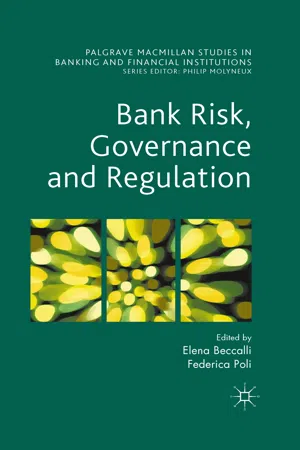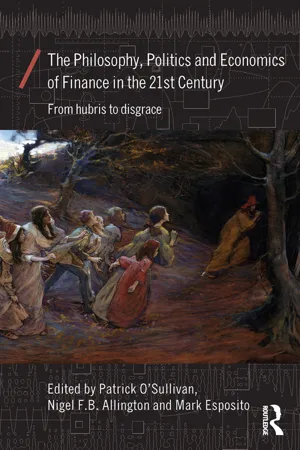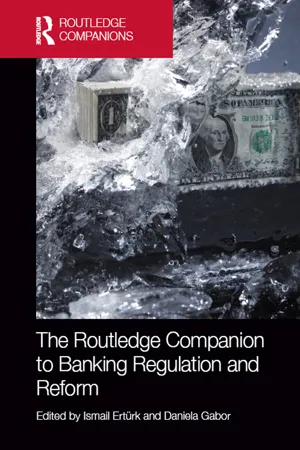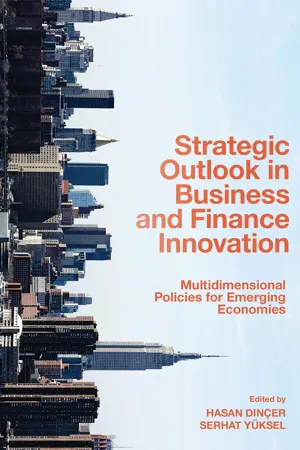Economics
Financial Innovation
Financial innovation refers to the development and implementation of new financial products, services, and processes. It aims to create more efficient and effective ways of managing financial resources, reducing risks, and increasing returns. Examples include the introduction of new financial instruments, such as derivatives, and the use of technology to improve financial transactions and services.
Written by Perlego with AI-assistance
Related key terms
Related key terms
1 of 4
Related key terms
1 of 3
6 Key excerpts on "Financial Innovation"
- eBook - ePub
- Elena Beccalli, Federica Poli(Authors)
- 2015(Publication Date)
- Palgrave Macmillan(Publisher)
The features of innovation in the banking sector are quite different from the characteristics usually encountered in other sectors. First, and in contrast to innovation in the manufacturing sector, a unique definition of Financial Innovation can be hardly found. For Frame and White (2004), Financial Innovation is defined as product and organizational innovation, which allows cost or risk reduction for the single bank and/or an improvement of the services for the financial system as a whole, but other definitions have been proposed as well. Second, banks are not the only developer of Financial Innovation. The banking sector is also an end user of innovations developed in other sectors. Sometimes, banks jointly develop innovation with non-financial firms, such as software houses or specialized technology firms. Very often, innovation happens thanks to interaction with clients, and so is spread over departments.Because of these features, the measurement of Financial Innovation is quite a challenge. Our chapter is closely related to recent literature addressing the open question of how to measure Financial Innovation. Studies of manufacturing innovation traditionally focus on research and development (R&D) spending. However, R&D is unlikely to be a satisfactory measure in banking, since banks do not usually have an R&D department that launches new products and services. Most new services are developed in an incremental way, often through ‘trial and error’ and in all parts of the business.A count based on the listings of new securities is not fully satisfactory either, since much of the innovation in financial services is not related to publicly traded securities, such as insurance and banking products (Lerner and Tufano, 2011). Furthermore, new securities are often minor variants of existing securities, issued by banks to differentiate themselves from competitors. Some studies on innovation in the banking industry attempt to catalogue one particular type of innovation, such as credit default swaps or securitization (Tufano, 2003). However these results cannot be easily generalized to other products. A recent suggestion is to consider patents by financial institutions (Arnaboldi and Claeys, 2014; Hall et al. 2009; Hunt, 2008), but Boldrin and Levine (2013) point out that academic studies have typically failed to find much of a connection between patents, innovation and productivity growth. - eBook - ePub
The Philosophy, Politics and Economics of Finance in the 21st Century
From Hubris to Disgrace
- Patrick O'Sullivan, Nigel Allington, Mark Esposito(Authors)
- 2015(Publication Date)
- Routledge(Publisher)
Financial Innovation is the advance of credit to buy assets such as land and housing (but later financial instruments as well) in which there was previously no market. Once credit may be used to buy an asset, that asset can also be used as security against future loans. Financial Innovation therefore develops markets in assets. Financial transactions increase, and balance sheets expand (Toporowski, 2010, Chapter 4). The major Financial Innovation of the second half of the nineteenth century was the emergence of markets in long-term finance for industry in Britain, following the passing of a succession of Joint Stock Companies Acts (1844, 1856, etc.) and the Limited Liability Act 1855 that allowed companies as a matter of legal routine to issue long-term securities. Similar legal developments quickly followed over most of Western Europe. In the economy as a whole, productive capital was able to secure a financial counterpart in long-term securities or liabilities held against industrial or commercial assets. Those securities were assets for their owners, had value, and could be traded in financial markets. It follows that they could be used as collateral (or security, hence the term “securities”) against bank loans. Such bank loans or credit created a second layer of financial intermediation on the underlying “real” assets. In its turn, bank credit may be used as security for further loans, adding a third, and possibly a fourth level of intermediation. More people became economically active in financial markets in an “unproductive” way, as defined in classical political economy. But this does not mean that finance is more dominant over the real economy, unless some further theory is advanced about the operations of the real economy - eBook - ePub
Contested Money
Toward a New Social Contract
- Matilde Massó(Author)
- 2023(Publication Date)
- Routledge(Publisher)
Most authors define Financial Innovation as the creation and diffusion of new financial products, processes, markets, and actors. However, Financial Innovation is much more than this. It transcends any narrow and linear definition of innovation that is limited to the oversimplified idea of deriving a technological application from a scientific discovery. It is, at the same time, a product and a process that involves multiple actors interacting in a complex development that ranges from the creation of new knowledge to its application and diffusion in a bidirectional process. This means that an ordered sequence of various stages does not exist. Innovations can be developed at any stage of the process and can be led by any of the participant actors:All aspects of a linear view of innovation have been criticized for several decades…. Nor is technological innovation simply the deduction of the implications of scientific discovery. Technologies may or may not draw upon science, and when they do they use it creatively as a resource rather than simply deducing its implications.(Mackenzie, 2009 , p. 32)Financial Innovation is fundamentally a co-performance process involving “actors in the wild,” particularly those in the social, cultural, and political context of day-to-day interactions (Mackenzie, 2009 , p. 69; Callon, 2007 ). In addition, the concept of co-performativity includes an important idea. It asserts that individuals and artifacts, that is, computers, pricing software, economic models, trading strategies, and regulatory structures, interact in a process of mutual learning and influence, in a recursive interaction performance.Financial Innovation involves the creation, promotion, and adoption of new instruments, products, platform procedures, and enabling technologies (Khraisha & Arthur, 2018 ). In this process, scientific knowledge that frequently comes from areas other than economics (fundamentally physics and mathematics), existing technology, the political context, and various categories of financial instruments and users interact in an embodied process of expertise (Mackenzie, 2009 ; Granovetter, 2005 - Ismail Ertürk, Daniela Gabor(Authors)
- 2016(Publication Date)
- Routledge(Publisher)
This conceptualization is radical because it implies that the work of Financial Innovation does not have a one-on-one correspondence with or any necessary basis in a specific knowledge or technology; new instruments are less central than they seem to be in much obsessive recent discussion of the credit crunch because instruments are only part of the process and often conjuncture-specific. Not all acts of bricolage have the same outcomes: only some bricolage involves and implies a conceptual shift in the nature of products or a redefinition in the relation between products, parties and markets, while similar forms of bricolage in different conjunctures can give rise to divergent outcomes. Finally, it is worthwhile remembering that bricolage is a way of reconceptualizing what agents do, whereas innovation in financial economics is a term of praise used by third parties to denote the assumed qualities of a new product and which, in retrospect, is attached to the heroic innovator or heroic technique as a title of praise. Innovation in this last sense is an illusion to be dissipated or, at least, understood in social constructionist terms as something ‘in the eye of the beholder’.(Interim) conclusionThe re-conceptualization of Financial Innovation set out above is an argument rather than a report on the results of primary research. In the next stage, empirical work will play an essential role in exploring and developing this conceptualization further, but our intention in this chapter has been to focus on the concept because many academic understandings of Financial Innovation have been characterized more by assertion than by interrogation. The imperative to understand Financial Innovation is not purely academic; as politicians and regulators seek to outline new regulatory regimes and political frameworks for the finance sector, these are partly framed by the implicit assumptions about what exactly happened. While interesting texts written by journalists and former insiders are emerging which provide first-hand accounts of specific decisions, actions and personalities (see, for example, Tett’s Fool’s Gold, 2009, which focuses on Morgan Stanley), these do not provide any broader conceptualization that puts such micro-level detail into a meso- and macro-context.By way of a conclusion to this conceptualization stage of our work, we have argued that Financial Innovation is not what it seems or, more precisely, not as it has been represented in a rationalistic frame. It is not the functionalist answer to real world deviances of financial markets from the neoclassical market model nor is it the product of heroic academic theorists or intermediaries. Instead, it is the outcome (or the emergent property) of the accidental coming together of structural preconditions, conjunctural situations and a repository of techniques, heuristic devices and skills that together form the resources of the cadre of (successful and unsuccessful) bricoleurs whose innovation is constructing chains.- eBook - ePub
Strategic Outlook in Business and Finance Innovation
Multidimensional Policies for Emerging Economies
- Hasan Dinçer, Serhat Yüksel(Authors)
- 2021(Publication Date)
- Emerald Publishing Limited(Publisher)
Tohidi & Jabbari, 2011 ). Therefore, all enterprises attempt to innovate for their survival and prosperity. However, in terms of the number and value of innovations, financial system is the leading sector. But the important question from the perspective of a nation and the society is “does any innovation in financial sector have any valuable impact on economic growth?”In order to make an evaluation about the nexus between Financial Innovation (FI) and economic growth, to stem the working process in financial system is worth mentioning. The financial system realizes transferring of funds from individuals who have excess funds at hand to those individuals who have a shortage. Financial system has a remarkable role in contribution to higher economic efficiency thanks to channeling funds from individuals who do not utilize it productively to those people who can use it effectively (Mishkin, 2016 ).From another perspective, FIs will lead to increased variety of financial products and services. Eventually, highly customized financial products and services will emerge which will cause to better matching of individual savers with those of companies raising funds for expanding and improving future products (Ertuğrul & Duran, 2020 ). As a result, obtained capital accumulation and higher economic efficiency will lead to economic growth (Chou, 2007 ). In addition, developing and innovating financial products and financial system is also main driver for economic growth (Dinçer, Yüksel, Korsakienė, Raišienė, & Bilan, 2019b ; Dinçer, Yüksel, & Martínez, 2019a ). Because such kind of development and innovations in financial sector will reduce asymmetric information, mobilize savings, allocate funds, facilitate trade, enhance corporate governance, and diversify risks (Levine, 1997 ; Pagano, 1993 ).In economic literature, there are two different thoughts which attempt to explain the nexus between financial improvement and economic growth. The proponents of the supply-leading view point out that financial development has a positive impact on economic growth (Beck, Levine, & Loayza, 2000 ; Calderon & Liu, 2003 ; King & Levine, 1993a , 1993b ; Levine, 1997 ; Levine, Loayza, & Beck, 2000 ; Schumpeter, 1911 ). The advocates of this thought indicate the existence of casual relationship running from financial development to economic growth. However, the proponents of the other thought which is demand-following view claim that financial improvement respond to changes in the real output level (Ireland, 1994 - eBook - ePub
Open Innovation: A Multifaceted Perspective (In 2 Parts)
A Multifaceted Perspective(In 2 Parts)
- Anne-Laure Mention, Marko Torkkeli(Authors)
- 2016(Publication Date)
- WSPC(Publisher)
9 also agree that communicating with customers during the NPD or NSD process has been identified as a critical success factor for companies in rapidly changing and highly competitive environments such as the financial services industry.4.3.Innovation
Vermeulen and Dankbaar34 define innovation as a new product, process, distribution method, or a new combination of existing products (or product components), processes or distribution methods, which are perceived as new by the stakeholders.Innovation is generally accepted as being of vital importance to obtain and maintain competitive advantage in any industry sector.9 ,10 ,38Building on the works of Chaston,41 Coelho and Easingwood,42 and Huang et al.,31 Chaston36 argues that innovation along with strategies of creating new products and services can be decisive for companies seeking to grow through an economic downturn and thereby outpace their competitors. Despite these findings, the financial services industry and especially banks are often considered to be low performers when it comes to innovation.18 ,38The lack of innovation in this sector is generally associated with the conservatism or rigidity of this sector,18 which may be explained by a lack of openness and the absence of an entrepreneurial orientation.It is an established fact that implementing strategic innovations permits companies to respond rapidly to fast changing market opportunities.13 ,17 ,36 ,38Yet, according to Bátiz-Lazo and Woldesenbet9 and Chaston,36 severe obstacles exist that prevent financial services firms from adopting technological innovations. Among those are resistance to change, organisational structures, cultural inertia, internal politics, fear of cannibalising existing products, fear of destroying existing competencies, satisfaction with the status quo, and, in general, a lack of incentives to abandon the certainty of the current way of doing things and to embrace the uncertainty of future rewards. This posture hampering open innovation is further reinforced by a traditional approach to innovation which strives to retain ownership and confidentiality of proprietary knowledge by adopting a “closed approach” to NPD and NSD.3
Index pages curate the most relevant extracts from our library of academic textbooks. They’ve been created using an in-house natural language model (NLM), each adding context and meaning to key research topics.
Explore more topic indexes
Explore more topic indexes
1 of 6
Explore more topic indexes
1 of 4





